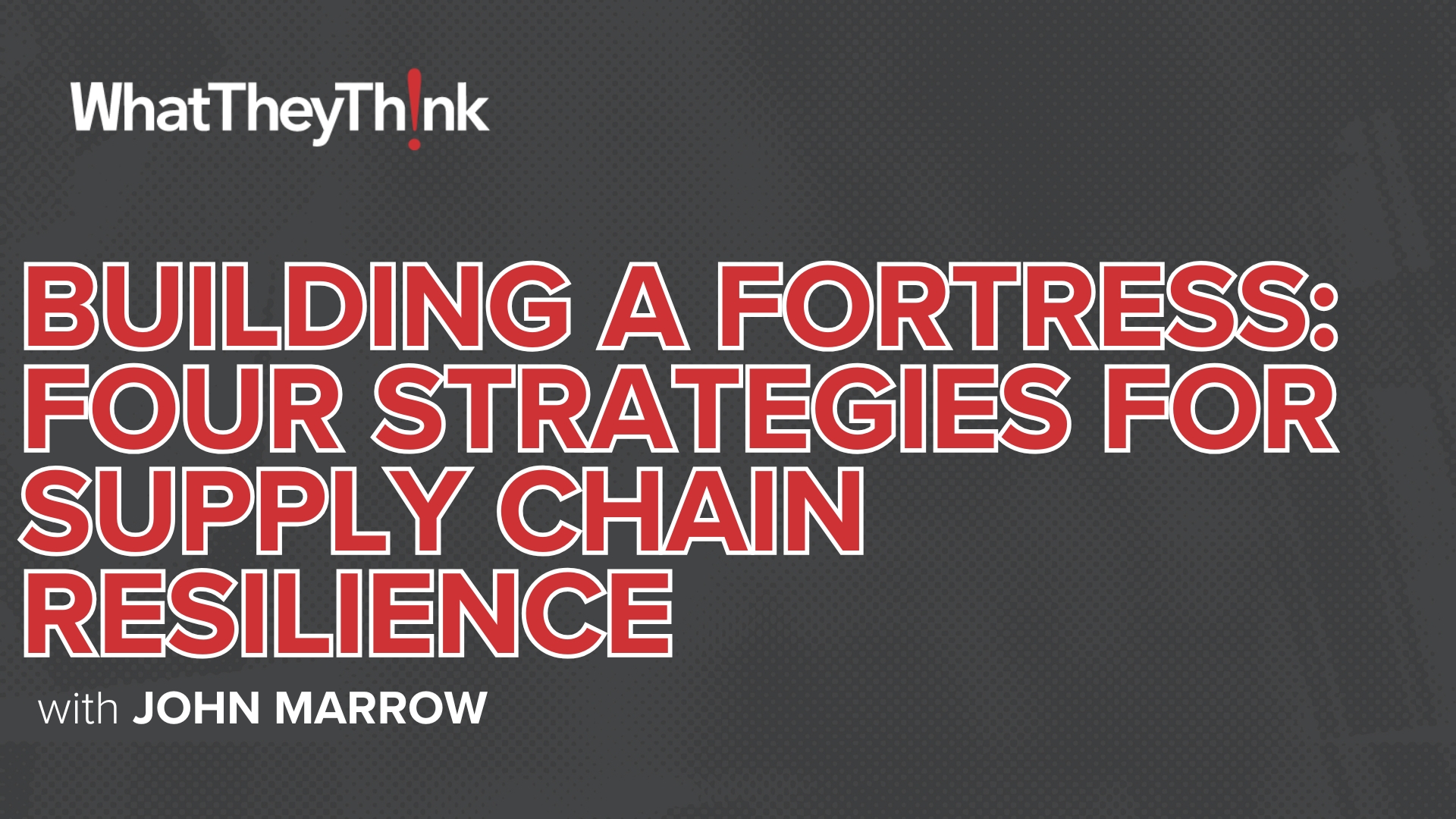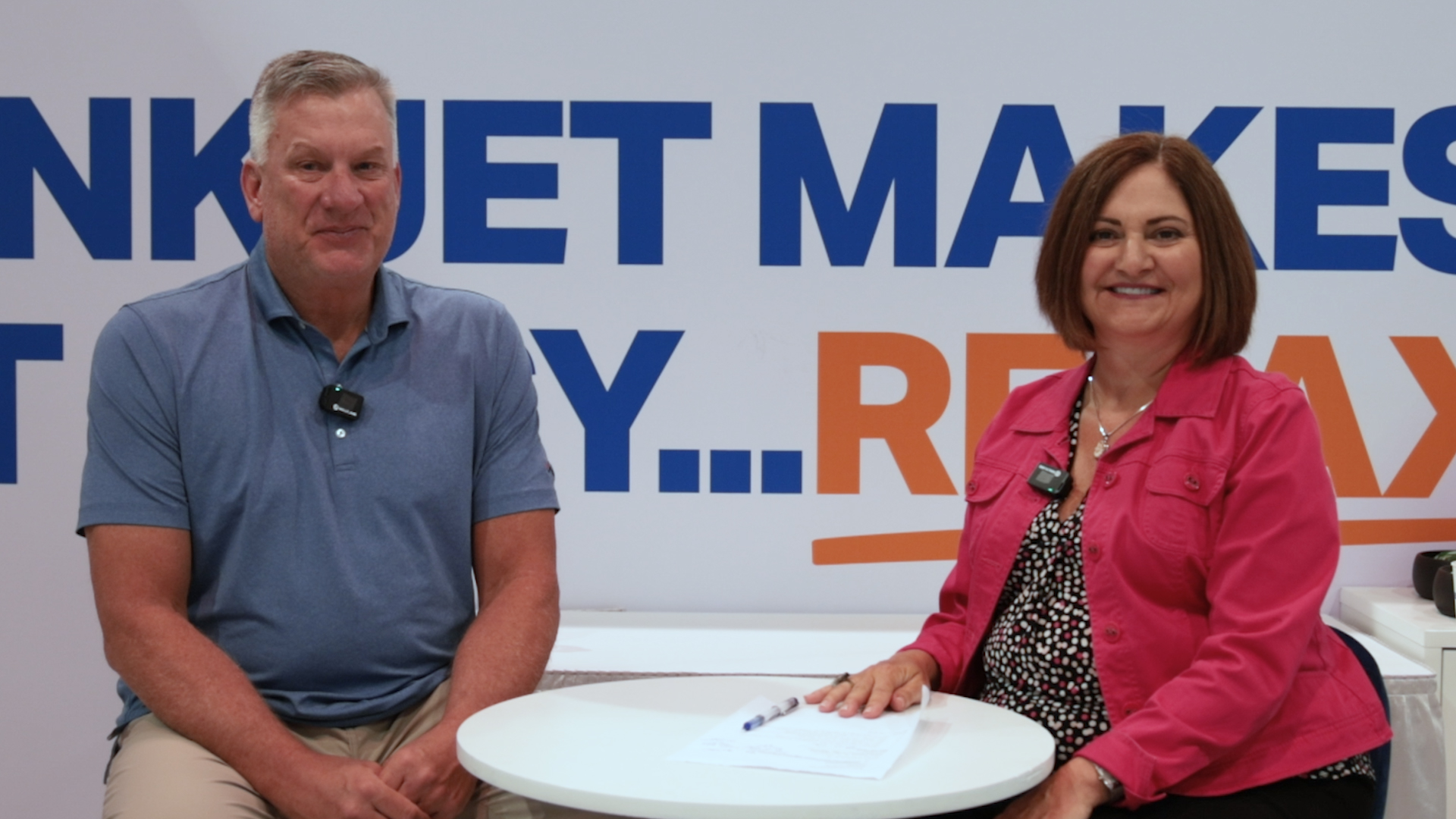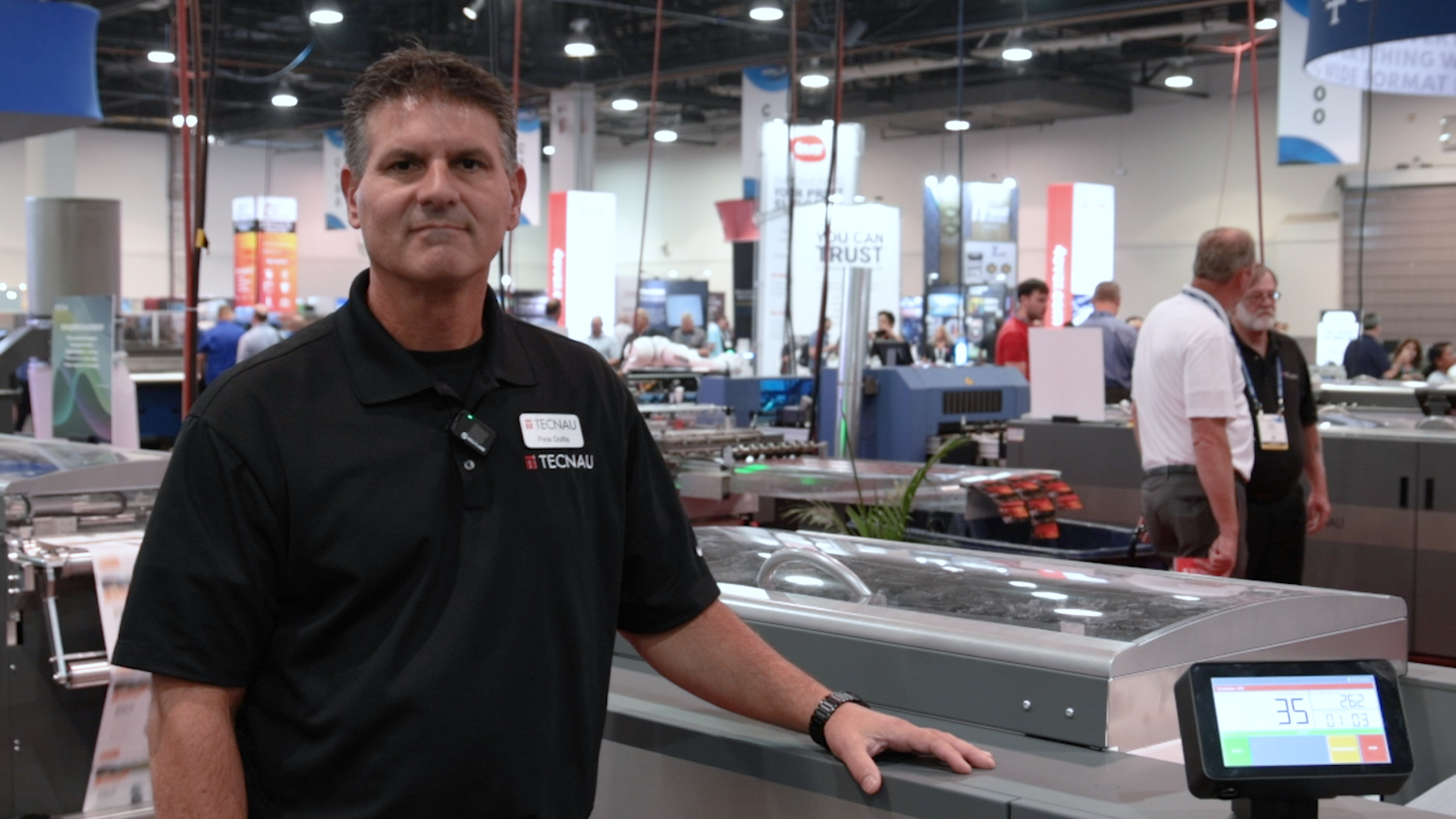Commentary & Analysis
Displaying 1851-1950 of thousands of articles
Insight You Need. Analysis You Trust.
Get the trusted insights you need to understand our evolving industry and emerging trends. Become a Premium Member.
The Cult of “Busy-ness” in Your Print Business
Being busy doesn’t equate to business success. Is your busy-ness leading you in the right direction? Or are you being led by your inputs? Prioritization takes uninterrupted time and discipline, it results in your activities having strategic direction.
Product Spotlight on FUJIFILM Samba JPC®
Most people familiar with production inkjet printing are aware of the FUJIFILM Jet Press® 750s (marketed as JPRESS in the U.S.) and the FUJIFILM DIMATIX Samba printhead used in that press. This article by Inkjet Insight’s Elizabeth Gooding discusses the capability of Fujifilm’s Samba JPC technology to meet the evolving needs of system integrators and OEM customers.
Textile Tech: Are You Prepared for Change in Textiles and Apparel?
New players are introducing new technologies for textile and apparel production and are poised to up-end the industry. Upheavals in the supply chain and rapidly changing consumer demands are starting to increase a sense of urgency, and more brands are looking seriously at how to effectively work on-demand or made-to-order manufacturing into their go-to-market processes.
Six Habits of Productive Printers: Are You Ready to Re-Emerge from the Pandemic?
During the pandemic, profitable printers had a shared characteristic: they were proactive in selling and didn’t wait for customers to come to them. Contributor John Giles looks at six habits that allowed printers to be profitable during the pandemic.
Preserving the Memory of John Wayne: SpeedPro Dallas Was Declared Winner of the 2020 Project of the Year Award
SpeedPro Dallas was recently announced as the 2020 winner of the prestigious SpeedPro Project of the Year award for its masterful work on behalf of “John Wayne: An American Experience.”
Around the Web: Paper Pigments. Athletic Air. Graphene Growth. Modern Medicines. Stamp Cipher. Tape Technology. Music Mural. Cover Catastrophes. Reflective Reindeer. Distasteful Dessert. Taco Trade.
Electronic paper can now have as many colors as an LCD display. The US Olympic Team will sport wearable air conditioners. What will be in the medicine cabinet of 2030? Decode the latest Forever Stamp. A roll of tape featuring programmable QR-like codes. A repository of horrible sci-fi book covers. Painting reindeer antlers with reflective paint to prevent traffic collisions. A treadmill for hamsters. Mac and cheese ice cream, for some reason. McCormick is hiring a “Director of Taco Relations.” All that and more in WhatTheyThink’s weekly miscellany.
Shipments: An Evening Out
May 2021 printing shipments came in at $6.59 billion, a slight downturn from April’s $6.87 billion, and the second consecutive month of decline, but is consistent with the pattern we have been tracking over the past five years.
The Motivation to Get Things Done
Decisions are not made in a void. They serve multiple purposes but the focus of this article is on stimulating action that moves us toward the accomplishment of goals. Last month we looked at the subject of approaching decisions in a structured way and in a way that used both sides of the human brain. The point was to make the best possible decision using what we know about how the brain works and how each side works to balance and inform the other. This month we look at finding and ensuring that the necessary motivation is in place for successful implementation of decisions and achievement of our goals
New Beginnings and Future Opportunities in Digital Print
In his inaugural submission to WhatTheyThink, Keypoint Intelligence’s Carl Doty contemplates new beginnings and future opportunities for growth in the printing industry.
Graduate Fashion Week: An Incredible Display of Resilience and Creativity
It has never been more important to shine a light on the achievements of students graduating with expertise in the textiles and fashion industry. Like many other industries, finding new talent is difficult. Textiles expert and WhatTheyThink contributor Debbie McKeegan shares the story of one award-winning graduate we hope will be an inspiration to future generations of students who might consider careers in textiles and apparel.
Turning QR Codes into Print Work
Why has one QR code usage gain traction when others haven’t? What lessons can we learn from it? Can QR code use be turned into further print work, even if the code itself “steals” certain types of business?
Print MIS Product Spotlight: EFI’s Midmarket Print Suite
This Print Software Product Spotlight looks at EFI’s Midmarket Suite. EFI’s “suite” approach to software solutions essentially pre-packages a group of products that already work together to solve end-to-end workflows.
European Print Industry Snapshot: Czech Republic
In this bimonthly series, WhatTheyThink is presenting the state of the printing industry in different European countries based on the latest monthly production numbers. This week, we take a look at the printing industry in the Czech Republic.
The Five Steps to Managing Pricing—Part 1
If you are struggling with setting prices or trying to decide when it’s time to change prices, Pat McGrew offers some starting points with this two-part series on five steps for managing pricing. This first part involves understanding your costs and your current pricing.
Stick it There: A Consumables Applications Photo Gallery
Variable-temperature graphics installation. Vaccine site graphics. Outside art exhibits. Home décor. Superbowl graphics from the Before Times. In this photo gallery, we highlight some recent projects that users have produced using a variety of consumables types, from labels, to vinyls, to fabrics.
Increasing the Value of Your Business: Ask Yourself These Key Questions Before You Sell
Print businesses often don’t sell because we don’t prepare them for sale. Contributor Tom Crouser offers tips for maximizing the value of a business above and beyond the company’s asset value.
The Target Report: Apollo Trades Textbooks for Wallpaper & Pillows—June 2021 M&A Activity
Shutterfly acquires Spoonflower, Cathedral expands, and more…
How Direct to Consumer is Changing Retail
Direct-to-consumer retail for apparel, once the domain of upstarts, is now being more seriously pursued by larger brands, a move that has been accelerated by the pandemic. What does this mean for brands and retail? Is another upheaval coming?
Greeting Card Publishers—2010–2018
According to County Business Patterns, in 2010, there were 10,258 employees in NAICS 511191 (Greeting Card Publishers). Over the course of the decade, employment has been up and down, reaching 13,690 in 2018. In sort of macro news, Las Vegas tourism traffic rose substantially in May 2021, as conventions were poised to reopen.
Around the Web: Paper Press. Tricky Typography. Excellent Electrode. Problematic Poultry. Silk Sensors. Augmented Art. Bottle Boards. Fireworks Fail.
A meticulously detailed paper model of a Heidelberg letterpress. “Algorithmic typography.” Graphene’s latest triumph. Birds aren’t real!! A new approach to wearable tech. An outdoor art installation is all AR-based. Cutting boards made from upcycled bottlecaps. A candy-pushing robot will stalk you in supermarkets. A model of Jabba the Hutt’s internal anatomy, for some reason. All that and more in WhatTheyThink’s weekly miscellany.
Adobe Expands Presence in Textile Design with New Creative Alliance
Adobe announced a creative alliance with Aquario Design and NedGraphics, two elements of the textiles portfolio of FOG Software Group, a division of Constellation Software. The alliance was announced by Adobe’s Mike Scrutton at the Smithers Digital Textile Printing conference underway in Arizona.
Five Reasons to Adopt Dye Sublimation: Discover New Opportunities for Growth
The textile manufacturing industry is on the cusp of dramatic change, driven by increased focus on restructuring fragile supply chains and growing consumer demand for more sustainable practices. Learn why heat transfer dye sublimation fabric printing can help meet these challenges by enabling responsive on-demand production of textile-based products.
Hybrid Workplaces: Having Your Cake and Eating It Too?
As is the case with many other things, the COVID-19 pandemic brought about many changes to the modern workplace. During the lockdown phase, many discovered that remote work was sometimes just as productive as work performed in an office. When we come out on the other side of the pandemic, what will the workplace of the future look like? This article explores the benefits—and possible pitfalls—of a hybrid workforce.
Looking Ahead with HP: HP’s GM Shares Insight and His Outlook for Production Inkjet Printing
Carles Farre, vice president and general manager, HP PageWide Press, talks about his background, current role, and views of the future of HP’s production inkjet business and the industry at large, including both commercial and corrugated applications.
Buying Strategic Software Features
A strategic feature of software is a value driver that generally has prerequisites in order to reap the benefits of the feature. The sales process generally skips the prerequisites (for obvious reasons). It is your responsibility as the buyer to understand precisely what it will take to reach the potential.
The Unboxing Experience: What’s Old Is New Again
Recently, Keypoint Intelligence released data from a new vertical market survey that reflects how a classic concept—unboxing—has become today’s news. No company illustrates the power of unboxing more than Apple.
Shaped by the Pandemic: Online Print in Germany
Online print made rapid progress in the last few years, and the country with the most advanced market for online printers is probably Germany. Needless the to say, that the pandemic did affect online print greatly as well. This article by European section editor Ralf Schlözer offers some insight on the effects and outlook.
Sharp/NEC and Avery Dennison Team Up for New Digital Window Graphics
ActiveScene is a projection system from Sharp/NEC combined with an “active” window film from Avery Dennison that can turn any window into dynamic digital signage.
Digital Schmigital: Who Hearts Offset Printing?
Literally trillions of printed pages still are reproduced worldwide each year using traditional offset press technology—not to mention “newer” offset product applications such as door hangers, pocket folders, and packaging. Contributor Mark Vruno looks at the latest developments in offset equipment.
Smooth Sailing in the Production Process: How to Ensure Your Artwork Files Won’t Slow You Down
Using error-free artwork files ensures that print production will go smoothly and that the result will be a timely delivery of your product. In this article, sponsored by HP and written by HP Indigo's “Workflow Chef” Gershon Alon, learn how to ensure the quality of your incoming artwork.
Reuse, Recycling, Upcycling: The Next Big Thing for Textiles
The pandemic has placed increased focus on supply chain issues in textiles and apparel, but a lot of this has been figuring out how to manufacture the same items more efficiently, especially Fast Fashion. But underneath it all, there is a burgeoning interest in better ways to extend the life of existing textile and apparel items—from reuse and recycling to upcycling. Will this be the next big thing for the industry, and how will it adapt?
Heidelberg CX 104 Aiming for Outstanding Price/Performance Ratio
It’s not a new top-of-the-line model, but the Heidelberg CX 104—launched last week at China Print— is a well-rounded, multi-purpose press with a good price/performance ratio. European section editor Ralf Schlözer identifies what sets the new B2 press apart from the other presses.
May Graphic Arts Employment—Getting a Little Better
In May 2021, all printing employment was up +0.7% from February, production employment up +1.4%, and non-production printing employment down -0.8%.
Around the Web: Cardiac Capture. Color-Coded COVID. Marvelous Mapping. Talented Titler. Cinematic Spectacles. Games Galore. Munching Mona. Thwarting Thieves. Crater Cuisine.
Graphene gets to the heart of the matter. Colored bracelets for wary shoppers. Data visualization studio turns street maps into watercolors. A look at Saul Bass and how he changed movie titles. New smart glasses designed as portable movie screens. A new archive of game show memorabilia to open in Rochester. A petition for Jeff Bezos to buy and eat the Mona Lisa. An app to help catch art thieves. A round up the latest fad: volcano-based cooking. All that and more in WhatTheyThink’s weekly miscellany.
Print MIS Product Spotlight: Lift Software
Lift Software Print MIS/ERP was invented inside a large wide format printer. That alone will tell you a lot about how Lift perceived the challenges of running a print business. For most Print MIS solutions, supporting wide format has been an add-on to a more traditionally focused offset or digital print manufacturing focus. For Lift it is clearly a deep specialty.
Pigment Solutions Take Center Stage in Direct-to-Fabric Printing
Digital pigment technologies have helped shape the customization culture that is prevalent among many of today’s online shoppers, and this technology is now making its way into textile DTF (direct-to-fabric). This article explores how pigment solutions are helping to fuel a revolution among textile printers.
Doing More With Décor—Opportunities, Innovations, and Applications for Interior Surfaces
Much of the discussion around the benefits of digital textile printing have focused on apparel, and its associated development and manufacturing processes as well as its supply chain issues. In this article, textiles expert and WhatTheyThink contributor Debbie McKeegan points out that home décor is also a high growth opportunity for digital textile printing and other forms of inkjet printing, including wall coverings.
QR Code Steals Client’s Business
For many printers and their clients, QR codes offer many opportunities for improved customer engagement and better customer service. But for some industries, they could actually represent the potential for lost business for printers, too.
The Print Geeks: Color Control 101
Highlights of a recent Print Geeks webinar in which resident geeks Jim Raffel and Shelby Sapusek of ColorCasters were joined by contributor Dan Gillespie of Alder Color Solutions to discuss five common areas where color management fails in the world of inkjet printing.
European Print Industry Snapshot: Poland
In this bimonthly series, WhatTheyThink is presenting the state of the printing industry in different European countries based on the latest monthly production numbers. This week, we take a look at the printing industry in Poland.
Top 100 Small Commercial Printshops for 2021
Each year, WhatTheyThink | Printing News invites small commercial print business owners to participate in our Top 100 Shops Survey. In this article, we look at the results of this year’s survey, and profile this year’s winners—including #1 Top Shop, Strategic Factory.
Canon Expands their Production Inkjet Portfolio with ColorStream 8000
Canon has the leading market share in production inkjet and has the widest range of production inkjet presses available. With the introduction of the ColorStream 8000, they are expanding their commercial production inkjet product line to further capture both toner and existing offset produced pages.
Smithers Digital Textile Printing U.S. Adopts Hybrid Conference Model
As things start to return to normal, conference organizers are looking for creative ways to reengage with their audiences. In the case of Smithers Digital Textile Printing U.S. (and its sister conference, Digital Print for Packaging U.S.), they have chosen to adopt a hybrid virtual/in-person model for both presenters and attendees.
What’s Your Digital Transformation Quotient?
One of the more important movements in the print industry is the inevitable trend of digital transformation—the transition from offset to digital. In this article, sponsored by HP and written by HP Indigo's “Workflow Chef” Gershon Alon, learn how print service providers can tackle this transition. What does the roadmap look like, and where does one begin?
Inviting Innovation: International Inkjet Experts Came Together June 14–18th, 2021, to Discuss Innovation
Last week, Inkjet Insight hosted Inkjet Innovation Week, a five-webinar series that looked at new developments and trends in five areas of digital inkjet printing. In developing these sessions, which are available for download, Inkjet Insight focused on true innovators and their innovations, and drew on an international group of experts to determine makes something innovative rather than just new.
Directory and Mailing List Publishers—2010–2018
According to County Business Patterns, in 2010, there were 41,489 employees in NAICS 51114 (Directory and Mailing List Publishing). Over the course of the decade, employment had plummeted to a low of 14,379. In macro news, new business creation has been at record highs.
Around the Web: Plexiglas Problems. Hat History. Dream Disturbance. Magnificent Material. Peace Portal. Hungry Humpback. Cocoon Calculator. Food Follies. Silly Slippers.
What is to be done with all those Plexiglas barriers when they come down? The history of the dunce cap. In-dream advertising? Graphene sensors can quickly detect COVID-19. A lobsterman is nearly eaten by a whale. Facemasks made of bread. When will you reach the Brimley/Cocoon Line (if you haven’t already)? An umbrella that converts into a poncho. Dyson’s new laser vacuum cleaner. The history of processed foods. Monty Python Dead Parrot slippers. All that and more in WhatTheyThink’s weekly miscellany.
Terry Raghunath of HP Shares His Insight and Experience for Printed Interior Decoration
There is a lot of focus on digital textile printing for apparel, but another great market opportunity for digital textile printing is interior décor. In this article, textiles expert and WhatTheyThink contributor Debbie McKeegan talks with Terry Raghunath, Business Development Manager for Printed Decorative Applications based at HP Barcelona, about market trends and how HP focuses its development efforts to meet them.
COVID’s Long-Term Effects on Office Equipment Vendors and IT Resellers
According to a Keypoint Intelligence study of 300+ office equipment dealers and IT resellers that sell A3 print technology and provide servicing, 50% of respondents said their customers are actively planning to change their print environments after the pandemic. This article explores the changes that office equipment vendors and IT resellers are planning as they emerge from the pandemic.
Making Better Decisions
In his last article, Wayne Lynn described the process of execution or “how we get things done.” It included making the decision to do something, finding the right motivation to get it implemented, and managing the stress that it naturally creates, being inventive as needed to overcome obstacles encountered along the way, and, finally, putting in place the policies and controls necessary to make sure the decision stays made but allows for changes in circumstances. In this article, Wayne examines the process of approaching a decision that increases your chances of success.
Who’s Tracking Direct Mail?
The Who’s Mailing What! Database contains an astounding wealth of information about direct mail. The database is growing by leaps and bounds, currently containing more than 130,000 mail pieces and with 13,000 mail pieces added every 30 days. Because these mail pieces are searchable, you can slice and dice the database any way you want—by industry, by sub-category, by search term, by color, by mailing format, and the list goes on.
Beware Of Shiny Things: How to Keep Your Focus on Your Priorities
WhatTheyThink contributor David Fellman writes about urgency and importance—specifically, how any task on your plate can be both of those things, just one of them, or neither of them. If you have more tasks on your plate than you have time in your day, it’s really important to know exactly where each one fits in terms of importance and urgency—and not to be distracted by “shiny things.”
Software Enabled Automation: What? Why? and How?
Software has evolved to allow automation with developers. Print businesses can take advantage of this if they invest in technical leadership and give them a seat at the decision-making table.
Vycom Expands its PVC and Acrylic Recycling Program
Vycom (and its parent, The AZEK Company) launched its Recycling Take Back Program in 2019, accepting hard-to-recycle materials like PVC and other materials used for signage and display graphics and reusing them in decking products, diverting millions of pounds of plastic from landfills. The company has expanded the number of recycling plants, has been adding customers, and is renewing its outreach efforts.
Johnson’s World—If It Is Ink On Paper, It Is Printing: Musings, Droppings, Streams, and Flashes
Digital print or conventional print? Do you have a preference? More importantly, do your clients? If it is ink on paper, it is printing. The rest is just labelling.
Where Brands are Headed with Mass Customization
Mass customization avoids many pitfalls of typical VDP projects because it doesn’t require the development of elaborate cross-sections of personal user data. In this article, sponsored by HP and written by HP Indigo's “Workflow Chef” Gershon Alon, learn how creating such campaigns is relatively worry-free and less complex, yet can be a very effective way of giving each individual the feeling of being unique.
Get Ahead of Your Competitors through Strategic Landmines
WhatTheyThink contributor Lisa Magnuson explains how to be pro-active and re-active toward your competition.
EFI Reggiani Announces New Products at ITMA Asia, Broadening Extensive Digital Textile Printing Line
In its first in-person trade show appearance since the pandemic began, EFI Reggiani displayed its dedication to ongoing innovation for textiles, even during this difficult time. Three new products were announced at ITMA Asia in Shanghai last Friday, as well as ink manufacturing capabilities in Asia and updates to the EFI Reggiani BOLT. Read the full story.
Around the Web: Outage Outrage. Toy Typing. Entomological Eating. Martian Melons. Sonar Strolling. Safe Strolling. HOV Hack. Sponge Songs. Regular Rejoycing.
Who was responsible for Tuesday’s Internet outage? LEGO launches a working model typewriter. Restaurant prevented from locally sourcing cicadas. The NYT reports that watermelons were found on Mars. Anyone can learn echolocation. An inventor creates a third eye for mobile phone addicts. The finalists in this year’s UK Shed of the Year Competition. The laziest carpool lane violator. Sponges that look like old cassettes. Three short videos by The Residents. Next Wednesday is Bloomsday. All that and more in WhatTheyThink’s weekly cicada-eatin' miscellany.
Shipments: A New Season?
April 2021 printing shipments came in at $6.80 billion, a slight downturn from March’s $6.98 billion, but is consistent with the pattern we have been tracking over the past five years.
Affiliates Are Positioned to Support Local Printing Communities
Following PRINTING United Alliance’s acquisition of the Printing Industries of America (PIA), the 21 local Printing Industries of Americas Affiliates joined together to see how they could work together to continue to support their local print communities. Cary Sherburne spoke with members of Affiliate Operating and Education Committees about their plans for the future.
Smart Print Manufacturing: The Future of Production Printing
Keypoint Intelligence has identified five core technologies (cloud computing, big data and analytics, artificial intelligence, robotics, and augmented reality) that will ultimately lead to mostly—if not fully—autonomous print production. This article explores the current state and future implications of our five core technologies for SPM.
Meet the Design Duo Breathing Life into Vintage Furniture Using Creativity and Print
Upcycling has become an important element of the circular economy, and furniture is no exception. Learn how this creative team is using digitally printed fabric to increase their ability to upcycle furniture and more!
And the Awards Go To…For this Year’s FASTSIGNS Project of the Year Award Winners, It’s All about Relationships
FASTSIGNS of Louisville (Ky.) took top honors at this year’s FASTSIGNS/Wide Format & Signage Project of the Year Awards. Second place was claimed by FASTSIGNS of Martinsburg (W.V.), and third by FASTSIGNS of Puerto Rico. Let’s take a close look at this year’s winners.
Recruiting Firm’s Perspective on Addressing the Aging Workforce
Arnie Kahn, president of PrintLink, a recruitment firm specializing in the printing industry, shares his insights on the challenges of maintaining the pipeline of skilled workers into the printing industry, along with some of the solutions and opportunities that a good staffing agency offers.
Document Your Processes—or Continue to Wing It?
The documentation of your repeating processes will change your business in so many ways. No matter how inefficient you might be today, the simple act of documenting processes and committing to iterative improvements will turn your business into a continuous improvement engine.
Power Your Print Business with Analytics
From the moment new work enters the business to delivery and invoicing, printing businesses are a mix of orchestrated and structured activities and ad hoc business decisions. Savvy print operations leverage smart automation because every touchpoint brings potential delays and costs. In this article, sponsored by Kodak, learn about implementing comprehensive automation that uses the power of artificial intelligence (AI), including Machine Learning (ML), to collect more data and provide deeper insight.
Let’s Do a Sales Team Tune-Up! Here’s Your Checklist!
Companies that have been in business for more than a few years usually have well-oiled sales machines, but mergers, acquisitions, changes in production capabilities, and market fluctuations could push the plan out of sync. That puts the business at risk. Sales needs to sell to the current capabilities and help set the strategy for future investments to support what customers are moving toward in their purchases. Contributor Pat McGrew identifies what items should be on your sales assessment checklist.
European Print Industry Snapshot: Belgium
In this bimonthly series, WhatTheyThink is presenting the state of the printing industry in different European countries based on the latest monthly production numbers. This week, we take a look at the printing industry in Belgium
What Will the Post-Pandemic Textiles & Apparel Industry Look Like?
As we begin to see the end of the pandemic (we hope), we wonder what things will look like on the other end. WTIN recently conducted a very informative webinar that touches on this topic and more. Worth a view! This article contains a summary of key information provided.
Time is Money—The Spot Color Matching Challenge
With more products and SKUs out there than ever before, converters must manage a larger number of short runs. As a result, they are spending a lot more time on spot color matching. In this article, sponsored by HP and written by HP Indigo's “Workflow Chef” Gershon Alon, find out how they are dealing with this challenge.
The Target Report: On Demand Everything—May 2021 M&A Activity
Printful Snags Unicorn Investment, Commercial Printing M&A Picks Up, and more…
Around the Web: Service Signage. Infrastructure Imperative. Guardian Goofs. Transparent Tree. Faux Forest. Kafka Collection. Auto Aggravation. Cow Concerto. Cereal Cyborg.
The park ranger who designed the iconic National Park signage. A report on the need for apparel recycling infrastructure. The Guardian looks back at its best typos. Making transparent wood. 3D printed wood. Franz Kafka’s letters, sketches, and other materials are now online. Coming soon: in-car advertising. Danish cellists play for cattle. Kellogg’s develops a cereal-making robot, for some reason. FDA warns about eating cicadas. Jell-O mold lamps. All that and more in WhatTheyThink’s Brood X weekly miscellany.
Book Publishing Employees—2010–2018
According to County Business Patterns, in 2010, there were 81,511 employees in NAICS 51113 (Book Publishing). Over the course of the decade, employment had dropped to a low of 64,085, but climbed back up to 73,108 in 2018. In macro news, the Great Rebound is underway.
What Are Acid Inks for Digital Textile Printing and Why Are They Used?
With the growing interest in and functionality of pigment inks for digital textile printing, you might wonder why one would still use acid inks. Textiles expert and WhatTheyThink contributor Debbie McKeegan explains.
The Paper Chase Challenge: Amid Shrinking Inventories and the COVID-19 Outbreak, Procuring Paper Is More Time-Consuming than Ever for Those Who Buy It
The COVID-19 pandemic worsened paper supply chain challenges that had been developing for the past several years. Contributor Mark Vruno looks at the problems print businesses have been having sourcing paper, the reasons behind those problems, and some of the workarounds that have been devised.
Implementing Inkjet Technology: Mistakes to Avoid
Implementing a new inkjet press can mean great things for your company’s productivity, but the purchasing process is not without its pitfalls. This article outlines some common mistakes to avoid (in terms of capacity and capabilities) when acquiring inkjet technology.
Seven Signs of Retail Recovery to Brighten Your Day
It’s rare that a survey is the bearer of truly good news, but the recent consumer attitudes survey out of McKinsey is one of them. Here are seven nuggets of good news from the survey that should make the grass a little greener and the sky a little bluer this morning.
Executive Q&A: Rainer Hundsdörfer, CEO of Heidelberger Druckmaschinen AG, and Cedric Muenzing, Head of Service of Heidelberg North America
European section editor Ralf Schlözer talks to Heidelberg CEO Rainer Hundsdörfer and Heidelberg North America Head of Service Cedric Muenzing about the impact of the pandemic on Heidelberg, the company’s trade event plans, the state of the Gallus business, and an update on the Zaikio platform.
Print Software Feature Overlap
Software solutions have features that overlap and are outright solving the exact same issues. Just be careful of the tendency to assume that a small feature means more than it really does. Be wary of where the feature gets done in your workflows.
One Year After Brexit—Evaluating the Impact on the UK and EU Print Industries
One year after UK exited the European Union, European section editor Ralf Schlözer looks at the impact of Brexit on the printing industry in both the UK and the EU—an evaluation complicated by the simultaneously occurring COVID-19 pandemic.
An Internal Indigo Study—How HP Indigo Customers Fared During the Pandemic and What We Learned
Indigo did some research to understand why some commercial print customers managed to come out ahead during the pandemic crisis—some even doubling their volume. This article, sponsored by HP and written by HP Indigo's “Workflow Chef” Gershon Alon, looks at the factors that made some print businesses more resilient than others.
Labels and Packaging: The Pandemic Provides New Opportunities Supporting Telemedicine
Telemedicine grew more than 6,000% during the pandemic. With that rate of growth, and no preparation, how were healthcare providers expected to provide the care needed remotely for seniors and others who were on extreme lockdown?
Around the Web: Growing Graphene. AR Aroma. Captcha Carnage. Literary Lycanthrope. Functional Footwear. Jittery Jeans. Snitching Stilton. Towel Tribute.
Watching graphene grow. Smell-O-Vision comes to virtual reality. Doom-inspired Captcha. John Steinbeck wrote a werewolf novel. Google is opening a physical store. Telescoping high heel shoes. “Optical illusion jeans.” A drug dealer is captured thanks to a picture of cheese. Last Tuesday was “Towel Day.” All that and more in WhatTheyThink’s super blood moon weekly miscellany.
Two Macroeconomic Indicators
This week’s Friday data dump looks at two macroeconomic indicators that will give us some sense of how we are bouncing back from the pandemic—the Industrial Production Index, and Retail Sales.
Laboring Through a Challenging Year
Post-pandemic, the business environment is changing rapidly. Balancing the needs of customers, operations, and the workforce is the big challenge employers now face. Guest contributor Lou Caron offers hiring strategies for printers needing to staff back up.
Thinking of Investing in DTG Technology? Five Considerations for Direct-to-Garment Printing
The Direct-to-Garment (DTG) business is booming. During the pandemic, businesses with online ordering capabilities explored new ways to add new solutions or capacity to their portfolios, and DTG was one of the key ways to do so. Learn more.
Study: The Business Danger of Public Politics
A new Shoppers.com study finds that Americans are more likely to boycott a brand due to their political positions than they were one year ago. So be careful how you post, share, and comment on your social media pages. You could be driving away potential customers.
Leveraging Automation and Industry 4.0 in Print and Packaging Manufacturing
Stakeholders in print and packaging have a new awareness that automation and Industry 4.0 will be what’s going to keep their companies competitive. It may be true, as it was for Granpak, a large packaging manufacturer, that implementing an MIS/ERP can impact an organization WITHOUT spending any additional money on machines or additional personnel.
What Problem are You Asking Print Software to Solve?
Lots of activity, little in the way of results is often the situation when your culture jumps to solutions without defining the problem first. Pause, say the problem out loud. Ask others to say it in their own words. Don’t move to the “how” until you all agree on the “what.”
Blowin’ in the Wind: Banner Finishing Is About More than Aesthetics
Even moderate winds can be destructive to outdoor graphics if they have been insufficiently reinforced. And while taping, sewing, or welding banner edges may not be the sexiest finishing techniques in the world, they are important considerations when producing outdoor graphics that are designed look good as well as last.
Are You Buying the Wrong Software? Valuable Tips to Tell!
It is very possible that the software in your workflow is not the best fit for your business! Business workflow suites and production workflow suites can be found for every size and type of business and at every price point. You can even find freeware for some of your common tasks. But just because it looks good and meets your budget doesn’t mean it’s the software for you. Pat McGrew explains how and why.
How to Participate in Industry 4.0 Part 5: Getting Data…and Now What?
In this fifth article of this series, we continue to look at Industry 4.0, not as a marketing term, but in an actionable way so that you can begin or continue to prepare your company and participate in the many benefits today and tomorrow. In this article, we look at a solution that provides some process connection points, data collection and analysis.
VDP De-Mystified
Personalization is a trend that’s not going away any time soon. Research shows that about 63% of consumers agree that personalization is now part of a standard level of service that they expect. This article, sponsored by HP and written by HP Indigo's “Workflow Chef” Gershon Alon, looks at the essential elements of a successful VDP program.
UBS Research Highlights Trends Fueling Fast Fashion Fires Threatening the Future of this Unsustainable Model
We recently suggested that the Fast Fashion trend should come to an end sooner rather than later, especially in today’s more sustainability-conscious environment and increased focus on solving climate change issues around the globe. In this article, we share insights from recent UBS and other research supporting this position and suggesting what happens if consumers cut back on fast fashion.
The Rise of Video Conferencing: Get Ready…Zoom Is Here to Stay
Video conferencing is becoming the business communication of choice because it engages the participants. Face-to-face conversations build trust, particularly since all parties can see the non-verbal cues. Contributor John Giles outlines the advantages and requirements for effective video conferencing.
Periodical Publishing Employees—2010–2018
According to County Business Patterns, in 2010, there were 134,432 employees in NAICS 51112 (Periodical Publishing). By 2018, employees had decreased to 84,424. In macro news, ecommerce as a percent of retail sales has dropped almost back to its pre-pandemic level.
Around the Web: Glorious Graphene. Crafty Captchas. Criminal Cookies. Robotic Writing. Android Art. Entomological Epicure. Bugless Bulbs. Floating Frankfurters. Perilous Pedaling.
A graphene-enhanced jacket for sailing. Why are Captchas getting harder? A bakery creates essentially a cookie-based wanted poster. AI writes bleak and depressing stories. AI paints “self” portraits, raising all sorts of existential questions. A cicada cookbook, for some reason. LED lightbulbs attract fewer insects than incandescents. Perfect for BBQ season: a levitating hot dog roaster. Learning to ride a penny farthing bicycle. All that and more in WhatTheyThink’s weekly miscellany.
Where Design Color and Textile Printing Interconnect, the Workflow Must Be Digital
As digital workflow increasingly makes its way into the textiles & apparel supply chain, how do you simplify the complex process that carries a creative piece of artwork through print production? That’s the question that Debbie McKeegan, textiles expert and WhatTheyThink contributor, addresses in this article.
Improving How We Get Things Done
It is a truism that most problems in today’s world of organizations are created by poor implementation of change initiatives. This stems from poorly thought out decisions all the way through to not putting in place clear decision boundaries that can prevent subversion of the desired outcomes. In this article, Wayne Lynn looks underneath the components of effective implementation with an eye toward creating a deeper understanding of what’s needed to improve our ability to improve how we get things done.
- Questions to ask about inkjet for corrugated packaging
- Can Chinese OEMs challenge Western manufacturers?
- The #1 Question When Selling Inkjet
- Integrator perspective on Konica Minolta printheads
- Surfing the Waves of Inkjet
- Kyocera Nixka talks inkjet integration trends
- B2B Customer Tours
- Keeping Inkjet Tickled Pink
© 2024 WhatTheyThink. All Rights Reserved.














